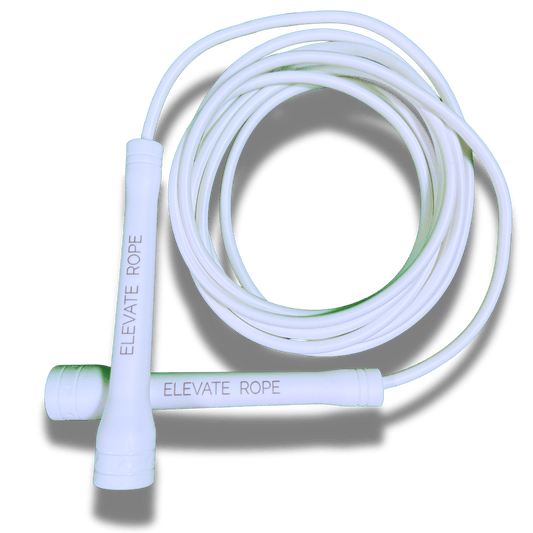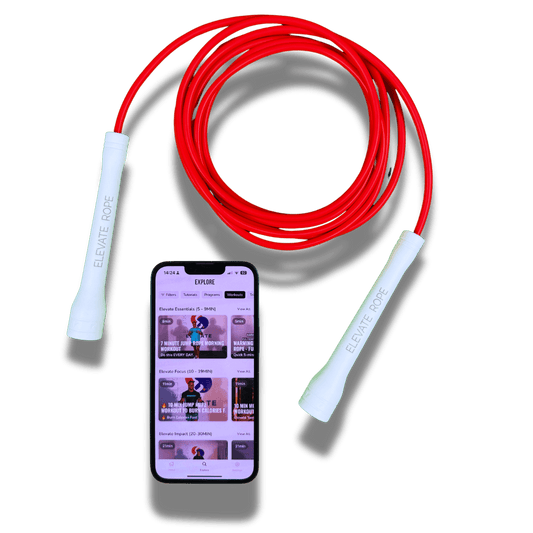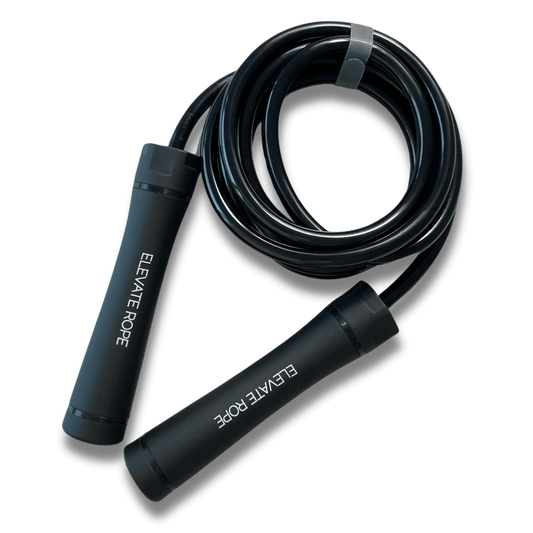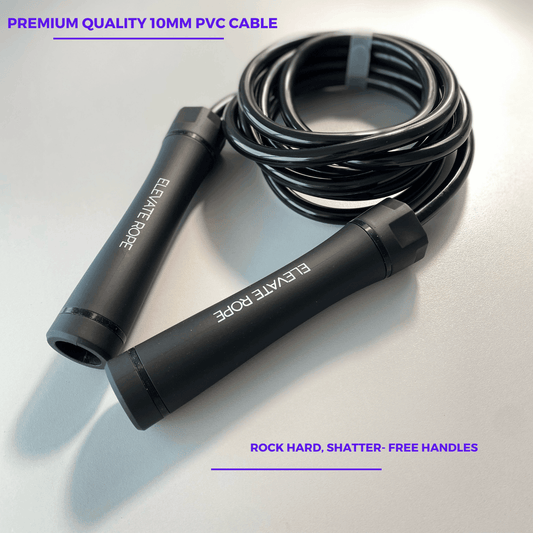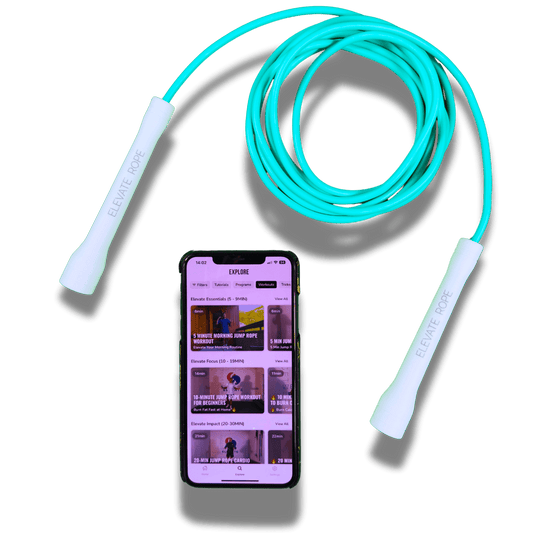15-Minute Jump Rope Workout (For Beginners at Home)
Are u too tired or too busy to work out to go try the jump rope motivation. You’re not alone. Many beginners struggle with motivation, and spending an hour at the gym often feels overwhelming. The good news: fitness doesn’t have to be complicated or time-consuming.
With just a jump rope and 15 minutes a day, you can improve cardio, coordination, and strength, all from home. No machines, no crowds, no excuses.
This is where Elevate Rope motivation comes in. Our approach is all about short, fun workouts that are easier to start and even easier to stick with. The rhythm of the rope, the energy of small wins, and the feeling of progress keep you coming back. That consistency is where the real transformation happens.
👉 Ready to try it? Follow along with our 15-Minute Beginner Jump Rope Workout on YouTube and experience how simple motivation can be with Elevate Rope.
👉 Ready to try it? Follow along with our 15-Minute Beginner Jump Rope Workout on YouTube and experience how simple motivation can be with Elevate Rope.
Why Choose a Jump Rope?
A jump rope is one of the most efficient fitness tools you can use — and the best part is, you don’t need to overthink which one to start with.
- Time-saving: 10–15 minutes of jump rope can deliver the same cardiovascular benefits as 30 minutes of jogging.
- Beginner-friendly: Moves like the basic bounce or boxer step are easy to learn, especially with a rope designed for feedback and control.
- Flexible & affordable: Train anywhere — in your living room, backyard, or even during a short break.
👉 Want to get started right away? Check out our Beaded Beginner Rope — perfect for learning, building rhythm, and staying consistent. It’s the easiest way to kickstart your Elevate Rope motivation.

Workouts
| Term | KD | Intent |
| 15 minute jump rope workout | Med | Do workout now |
| jump rope workout for beginners | Med+ | Start, easy plan |
| beginner jump rope workout home | Med | Home + beginner |
| quick home workout no equipment | High | Broad top-funnel |
| how to get motivated to workout | High | Motivation info |
| easy workouts for beginners home | Med+ | Ready-to-do |
| 10 minute jump rope workout | Med | Shorter than 15 |
| jump rope weight loss beginner | Med | Outcome focused |
| best jump rope for beginners | Med+ | Product research |
| beaded vs speed rope | Low | Gear comparison |
| weighted jump rope benefits | Med | Heavy rope angle |
| jump rope HIIT workout | Med+ | HIIT intent |
| 7 day jump rope challenge | Med | Challenge opt-in |
| 14 day jump rope challenge | Low | Challenge opt-in |
| 25 day jump rope challenge | Low | Brandable challenge |
| morning 15 minute workout | Med | Habit stacking |
| workout when unmotivated | Med | Pain-language |
| no time to workout plan | Med | Time-barrier solution |
| accountability workout challenge | Med | Community + accountability |
Elevate Rope Motivation Tracks (7/14/25 Days)
We all know motivation doesn’t last forever. Some days you wake up ready to crush a workout, other days you barely feel like moving. That’s normal. The problem is relying on “motivation bursts” alone — they fade quickly, and so do your results.
That’s why we designed the Elevate Rope Motivation Tracks: 7, 14, and 25-day programs that build consistency step by step. Each track is built to give you structure, accountability, and daily proof that fitness can be simple. With jump rope motivation at the core, you’ll discover how much easier it feels to keep going when workouts are short, fun, and guided.
When motivation fades, structure and community keep you moving. That’s the secret behind Elevate Rope motivation.
🔹 Elevate7 Reset
7 days • Perfect for beginners
The Elevate7 Reset is your fast start. In just one week, you’ll complete short 10–15 minute workouts that focus on simple jump rope skills and light conditioning. It’s designed to give you quick wins and help you rediscover your rhythm.
By day 3, you’ll already feel the difference in your energy levels. By day 7, you’ll prove to yourself that you can stay consistent. These quick wins are the foundation of jump rope motivation — progress you can actually feel.
👉 Join Elevate7 and jumpstart your motivation today.
🔹 Elevate14 Challenge
14 days • Build consistency
After the reset, it’s time to level up. The Elevate14 Challenge takes your new rhythm and transforms it into a real habit. Each day introduces structured routines with small variations — from boxer steps to basic HIIT intervals — so your workouts stay fresh and exciting.
By the end of two weeks, you’ll notice fewer excuses, more energy, and the confidence that comes from sticking with something every day. That’s the power of jump rope motivation: once you feel momentum, you don’t want to stop.
👉 Join Elevate14 and keep the momentum alive with Elevate Rope motivation.
🔹 Elevate25 Challenge
25 days • Workouts & Transformations
This is where the real transformation happens. The Elevate25 Challenge is nearly a full month of guided routines that combine cardio bursts, HIIT sessions, and skill drills. It’s designed to push you just enough to see visible results while keeping sessions short and doable.
By the time you complete 25 days, workouts won’t feel forced anymore — they’ll feel natural. You’ll build not only stamina and strength, but also the discipline that turns fitness into a lifestyle. At this stage, jump rope motivation becomes second nature: you don’t wait for motivation to strike, you show up because it’s part of who you are.
👉 Join Elevate25 and make motivation your lifestyle.
✨ Together, these tracks are more than just workouts. They’re a system built around jump rope motivation: helping you overcome excuses, build confidence, and finally stay consistent. Whether you start with Elevate7, progress into Elevate14, or challenge yourself with Elevate25, you’ll always have the structure and support you need to succeed.
Form & Safety Quick-Start
Before you dive into your first 15-minute session, there’s one thing that can make or break your success: good form and a safe setup.
Here’s the truth: nothing kills motivation faster than frustration or injury. You’re excited to start, but if your rope feels too long, your shins ache from the wrong surface, or you trip every second, you’ll be tempted to quit. That’s why we built this Form & Safety Quick-Start guide — to help you nail the basics, avoid common mistakes, and keep your jump rope motivation alive from day one.
1. Setup: Rope Length & Space
The first step is making sure your rope actually fits your body.
- How to check: Step on the middle of your rope, pull the handles upward. They should reach just about to your armpits.
- Too long? The rope will slap the floor and make you trip.
- Too short? You’ll clip your feet and shoulders will tense up.
👉 Need help adjusting? Watch our YouTube rope length tutorial.
Space matters too:
- Clear at least 2 meters above your head (watch for low ceilings or lights).
- Make sure the floor is clear — no rugs, wires, or objects nearby.
2. Posture & Form
Good posture makes jump rope efficient and safe. Here’s what to focus on:
- Stand tall: Keep your shoulders relaxed, chest open, and core engaged.
- Elbows in: Tuck elbows close to your body, forearms angled slightly out.
- Wrists turn the rope: Avoid big arm circles — it wastes energy. Small wrist rotations are enough.
- Small jumps: Just 2–3 cm off the ground is plenty. Stay light on your feet.
- Soft landings: Land on the balls of your feet with a slight bend in the knees to absorb shock.
These small details make jumping smoother and less tiring. More importantly, they keep you motivated because you feel in control rather than clumsy.

👉 See proper technique in this blog about posture.
3. Surface: Protect Your Joints & Rope
Not all surfaces are equal when it comes to jump rope. Training on the wrong one can lead to sore joints and worn-out ropes.
- ✅ Best surfaces: wooden floors, gym mats, rubberized flooring.
- ⚠️ Avoid: asphalt or rough concrete. These surfaces are hard on your knees and ankles and shred your rope quickly.
If you don’t have access to a gym surface, use a portable jump rope mat. It cushions impact, protects your joints, and helps your rope last longer.
4. Footwear Choices
The right shoes can make a huge difference in how your body feels after a workout.
- Best: Lightweight training or cross-training shoes with some cushioning.
- Barefoot option: Some athletes prefer barefoot training for better foot strength, but only do this on a soft mat.
- Avoid: Thick running shoes — they’re too heavy and slow down your rhythm.
Your feet are your foundation. Protect them, and you’ll protect your motivation to keep showing up.
5. Warm-Up & Cool-Down
Skipping warm-ups is tempting, but cold muscles increase the chance of injury. You only need a couple of minutes:
- Before: ankle rolls, calf raises, wrist circles, light jogging in place.
- After: calf stretches, hamstring stretches, shoulder rolls.
It doesn’t need to be complicated — just enough to tell your body “we’re moving now.” These small rituals also act as habit triggers, reinforcing your jump rope motivation loop.
6. Safety Basics to Keep Motivation Alive
- Start small: Begin with 5 minutes, then work up to 15.
- Expect trips: Everyone trips — even pros. Instead of frustration, think of each reset as part of the process.
- Listen to your body: Mild soreness = normal, sharp pain = stop and rest.
- Stay hydrated: Dehydration leads to fatigue, which kills motivation fast.
Why Form & Safety Fuel Jump Rope Motivation
Think of this section as your insurance policy. When your rope fits, your form feels smooth, and your setup is safe, every session becomes easier. And when workouts are easier, you don’t dread them — you look forward to them.
That’s the real power of jump rope motivation: not waiting for willpower to magically appear, but creating an environment where success feels natural.
Motivation Toolkit
Even the best workout plan will fail if you don’t feel like starting. Motivation is often the missing link — not because people don’t care, but because life gets in the way. That’s why Elevate Rope created a simple toolkit to help beginners and busy people stay consistent. These strategies are designed to turn “I’ll do it tomorrow” into “I’ll do it now.”
1. Habit Triggers
One of the easiest ways to stay consistent is to connect your workout to something you already do every day. Think of it as stacking habits. For example, after your morning coffee, jump rope for five minutes. Or every time you finish work, grab your rope before you sit down. Over time, these cues train your brain to expect movement. This is how jump rope motivation becomes automatic instead of forced.
2. Quick Wins
The fastest way to kill motivation is to set the bar too high. That’s why quick wins are powerful. Completing just five minutes of jumping proves to yourself that you can do it. That feeling of accomplishment — even from something small — is addictive. The next day, you’ll want to repeat it, maybe even add a few more minutes. This steady build is the foundation of lasting jump rope motivation.

3. Accountability
When it’s just you and your willpower, excuses are easy. But when you commit to a plan, a challenge, or a partner, accountability takes over. Knowing that you’ve made a promise — even if it’s just writing down your workouts — helps you push through low-energy days. Accountability removes the decision-making process and replaces it with structure, which fuels consistency and, in turn, motivation.
4. Community Energy
Motivation doesn’t have to come from within alone. Training with others, even virtually, can multiply your energy. Seeing other people hit their goals, share their struggles, or celebrate small wins reminds you that you’re not in this alone. Community energy is contagious. Surround yourself with like-minded people, and your jump rope motivation will rise naturally.
5. Progress Tracking
What gets measured gets repeated. Tracking your progress — whether it’s fewer trips, longer unbroken streaks, or your first 15-minute session — gives you visible proof that you’re improving. These micro-wins are powerful motivators. Each time you see evidence of progress, your confidence grows. That confidence becomes the fuel for your next workout.
Why This Toolkit Works
Motivation isn’t something you find; it’s something you build. By using habit triggers, quick wins, accountability, community, and progress tracking, you create an environment where consistency thrives. And once consistency takes over, you don’t have to rely on willpower anymore. That’s when jump rope motivation becomes part of your daily life.
Frequently Asked Questions (FAQ)
When you’re just starting out with jump rope, questions are normal. In fact, many beginners give up not because the workouts are too hard, but because they’re unsure if they’re doing things the right way. Below you’ll find answers to the most common questions, written to help you stay confident and motivated.
Is 10–15 minutes of jump rope really enough?
Yes — and this is one of the best-kept secrets of fitness. Studies have shown that 10–15 minutes of jump rope can deliver similar cardiovascular benefits to 30 minutes of jogging. That means you can achieve powerful results in half the time.
For beginners, this is a game-changer. Instead of needing to block out an hour for exercise, you can focus on short, effective sessions. This is exactly why jump rope motivation works so well: when workouts are short and manageable, it’s easier to start and easier to stick with them.
2. Can I jump rope every day?
It depends on your current fitness level and how your body responds. Beginners often do best with 3–4 sessions per week, allowing time for muscles and joints to adapt. As your stamina improves and your technique becomes smoother, daily jump rope sessions are possible.
The key is listening to your body. Mild soreness is normal, but sharp pain or persistent discomfort means you should rest. Remember, the goal isn’t to push so hard that you burn out — the goal is to stay consistent. Consistency, not intensity, is the foundation of lasting jump rope motivation.
3. How do I know if my rope is the right length?
A rope that’s too short or too long can make jumping frustrating. Here’s a quick test:
- Step on the middle of your rope.
- Pull the handles upward.
- They should reach your armpits.
If the handles stop at your chest, the rope is too short. If they go past your shoulders, it’s too long. Adjusting to the right length makes every jump smoother and more efficient. When the rope feels natural in your hands, you spend less energy fighting mistakes and more energy enjoying the workout. That comfort is what keeps jump rope motivation alive.
4. Can I lose weight with jump rope?
Absolutely. Jump rope is one of the most effective calorie-burning exercises you can do. On average, a 15-minute session can burn between 150 and 200 calories, depending on your intensity and body weight. Over time, this adds up significantly — especially when combined with a balanced diet.
But the real secret isn’t just calorie burn. The true weight-loss power comes from consistency. Jump rope is simple, fast, and fun, making it much easier to stick with compared to long gym sessions. And consistency is the ultimate driver of results. That’s why jump rope motivation is central: it helps you keep showing up, even on days when you don’t feel like it.
5. What’s the best jump rope for beginners?
Beginners often do best with a beaded rope. Beaded ropes provide feedback you can hear and feel, which makes learning timing and rhythm much easier. They’re also durable and don’t tangle easily. A rope that helps you feel successful early on fuels your confidence — and that confidence builds your motivation to keep training.
6. How often will I trip, and is that normal?
Tripping is part of the process. Even experienced athletes trip occasionally. At the start, you might trip every few jumps. Over time, with practice and patience, you’ll notice fewer and fewer mistakes. The key is not to get frustrated. Think of every trip as a reset — an opportunity to improve your focus and timing. Staying calm and continuing after each mistake is what keeps jump rope motivation strong.
7. Do I need special shoes or equipment?
You don’t need much. A simple rope and some supportive training shoes are enough. If you prefer barefoot training, use a soft mat to protect your joints. What matters most is consistency, not fancy gear. Simplicity is one of the main reasons jump rope is so motivating: anyone can start, anywhere, with minimal setup.
8. Will jump rope improve my overall fitness?
Yes. Jump rope is not only a cardio workout but also improves coordination, agility, balance, and endurance. It strengthens muscles in your legs, core, and shoulders while sharpening your reflexes. Many athletes, from boxers to football players, use jump rope as a key part of their training. For beginners, this all-round benefit means you get more results from less time — another huge win for jump rope motivation.
9. What if I don’t have time?
That’s exactly why jump rope works. In just 10–15 minutes, you can complete a session that delivers major benefits. You don’t need to drive to the gym or wait for equipment. All you need is your rope and a small space. For busy people, this time efficiency is the ultimate motivator. When something only takes 15 minutes, it’s much harder to say no.
10. How do I stay motivated on days I feel tired?
This is where the Elevate Rope philosophy comes in: don’t rely on motivation alone. Use structure, habits, and accountability. Start with just 1–2 minutes of light jumping — often, once you get moving, the energy comes naturally. Focus on small wins instead of perfection. And remind yourself: consistency is what creates results. Every short session adds up, and every session reinforces your jump rope motivation.
Why This FAQ Matters
Questions are a natural part of any fitness journey. The key is having clear, simple answers that remove uncertainty. When doubts disappear, motivation grows. That’s the heart of jump rope motivation: building a foundation of confidence, clarity, and consistency so you can focus on what really matters — showing up.





